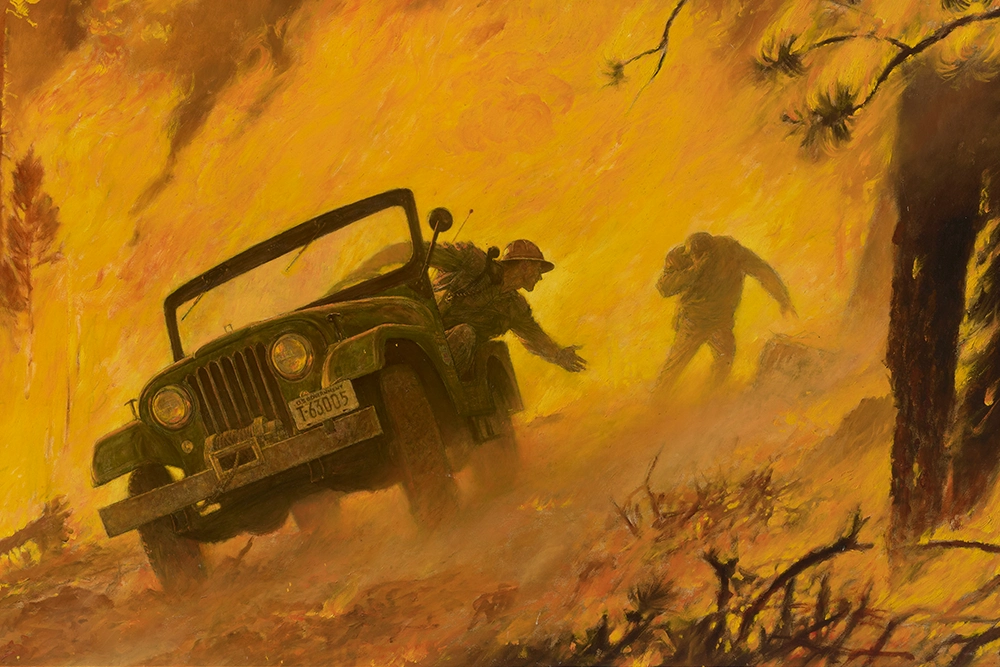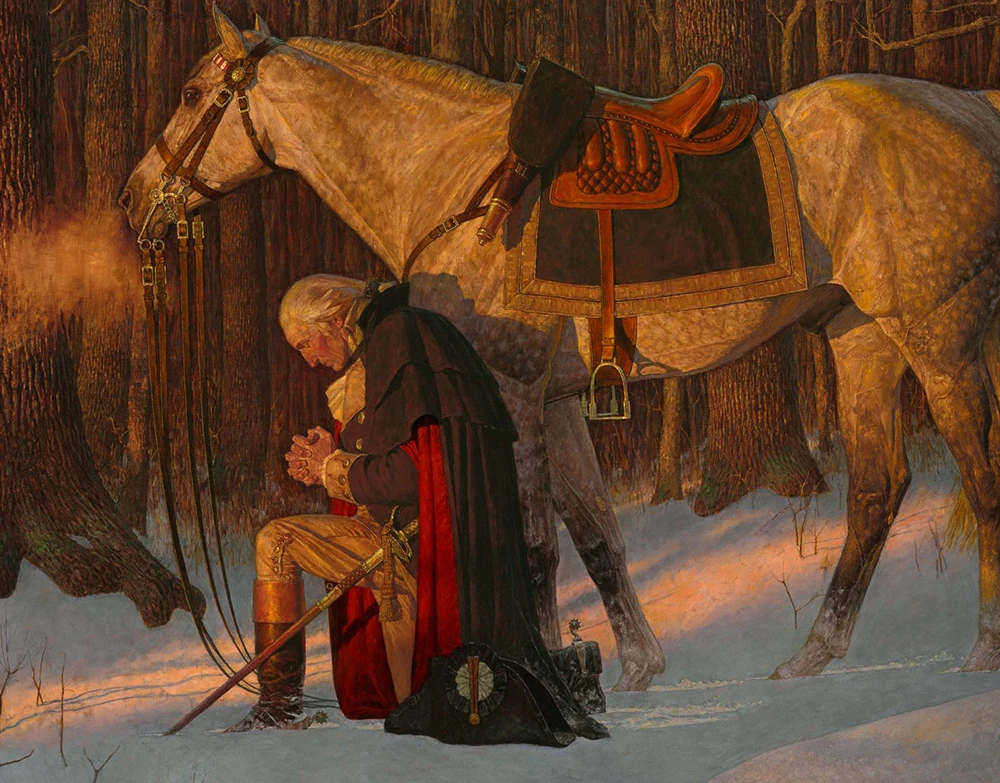
The Prayer at Valley Forge is a poignant portrayal of General George Washington during one of the most critical moments in American history. In the harsh winter of 1777-1778, amidst the immense hardships faced by the Continental Army at Valley Forge, Washington is depicted in a moment of solitary prayer, seeking guidance and strength. Friberg's use of oil paint masterfully conveys the biting cold and desolate nature of the scene. The skin on Washington’s hands and face is cracked and dry, his fingers a bulging scarlett as he clasps them tightly with resolve. Meanwhile, a solitary beam of celestial light provides a brief respite of warmth as it breaks through the dark arboreal thicket that surrounds him, illuminating the almost audible breath of his famous mount as he exhales softly into the cold. The presence of Blueskin, Washington's faithful gray stallion, adds a layer of authenticity and emotion, serving as a silent witness to the depths of Washington's resolve. This artwork transcends the boundaries of mere historical depiction, offering a window into the soul of the man whose leadership was instrumental in the fight for American independence and who would emerge as the nation's first president. Friberg's intention was not only to recall the physical conditions of that time but to honor the spirit of perseverance and unity that Washington embodied.


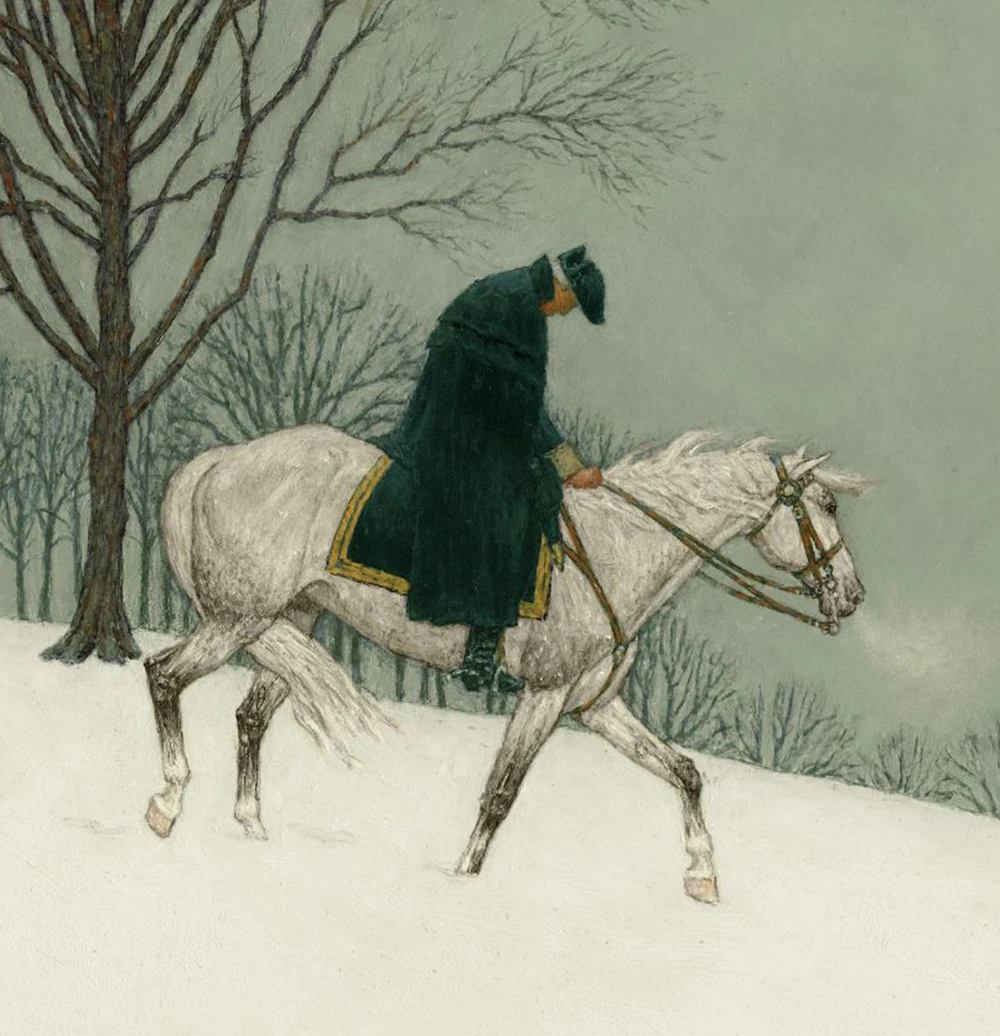
Winter at Valley Forge encapsulates the resilience and determination of General George Washington and his Continental Army during one of the Revolutionary War's most testing times. Despite the extreme human conditions—the biting cold and scarcity of essentials like food, water, and warm clothing—Washington’s leadership shines through as a beacon of hope and strength. Friberg's work goes beyond the physical hardships of that winter, capturing the profound emotional depth and steadfast commitment to the cause of freedom. Within the composition a strong wind blows at Washington’s back, pushing Blueskin’s tail and mane forward, while Washington bows his head in deep contemplation of the path ahead. Friberg includes a few sparse trees dotting the frozen white landscape, communicating the lack of aid and resources of this harrowing time. Still, Washington and his horse soldier on, forging a new path through the snow. The painting vividly portrays the spirit of perseverance that led these men through adversity, with tracks in the snow symbolizing the arduous path to independence. Through this artwork, Friberg pays tribute to the enduring fight for freedom and the foundational leadership of America's first president, highlighting the authentic emotion and indomitable will that guided the nation to its future.


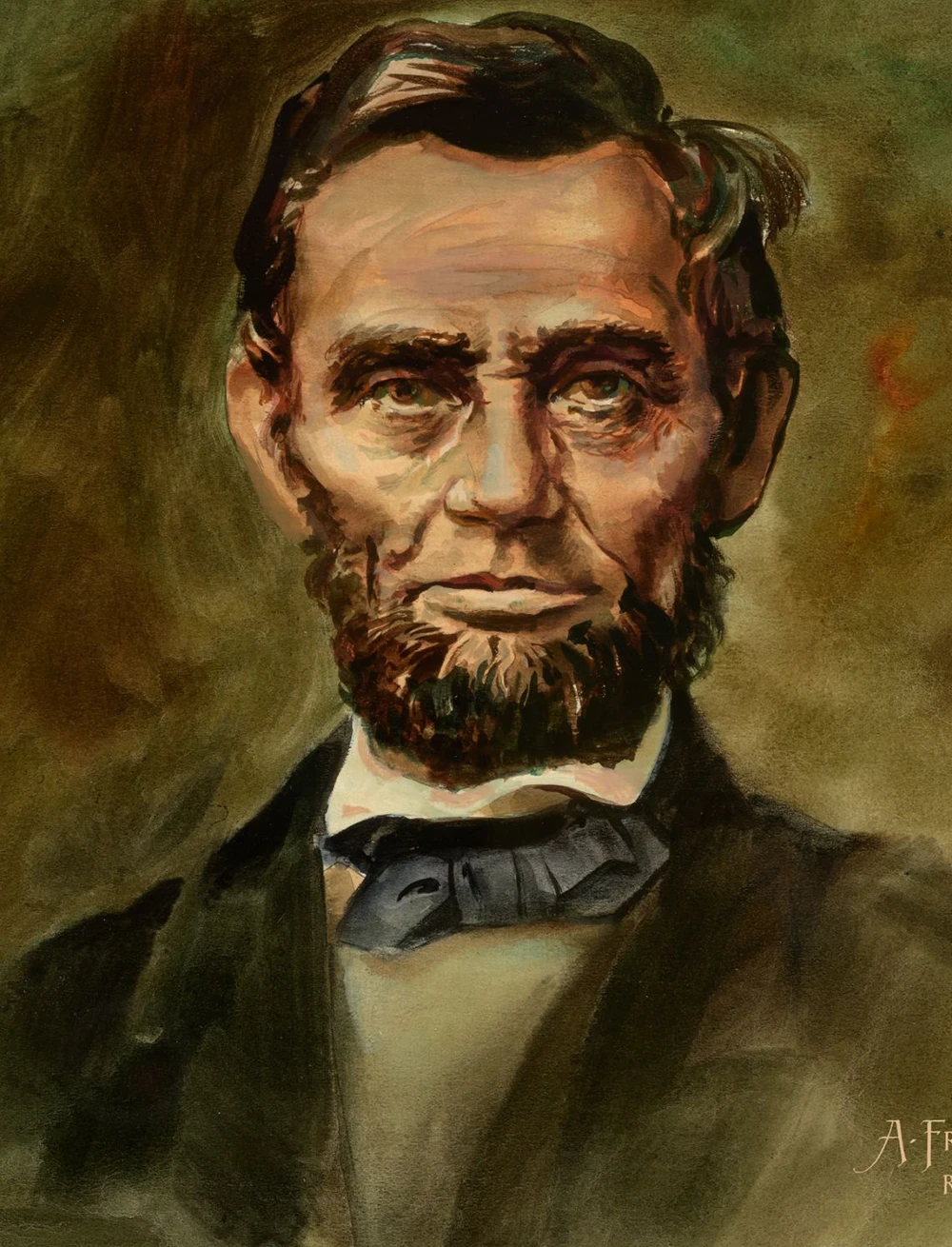
Portrait of Abraham Lincoln captures the essence and soul of the 16th President of the United States with profound depth. Through the expressiveness of Lincoln's eyes, the painting conveys his wisdom, compassion, and the resilience of a leader who rose from poverty to steer the nation through its most turbulent times. Inspired by the famous Gettysburg Portrait taken by Alexander Gardner just weeks before Lincoln would address the nation on that hallowed ground, Lincoln’s visage appears to emanate light, as Friberg depicts him with a steely resolve. The titular figure stands just off-center in stark contrast to the large, visible brushstrokes that populate the scene to the left, evoking a chaotic energy against which Lincoln stands stalwart and resolute. Friberg's intentionality in this piece transcends a mere historical depiction, offering a moment of reflection on the enduring values of leadership and the indomitable spirit of one of America's most revered figures.


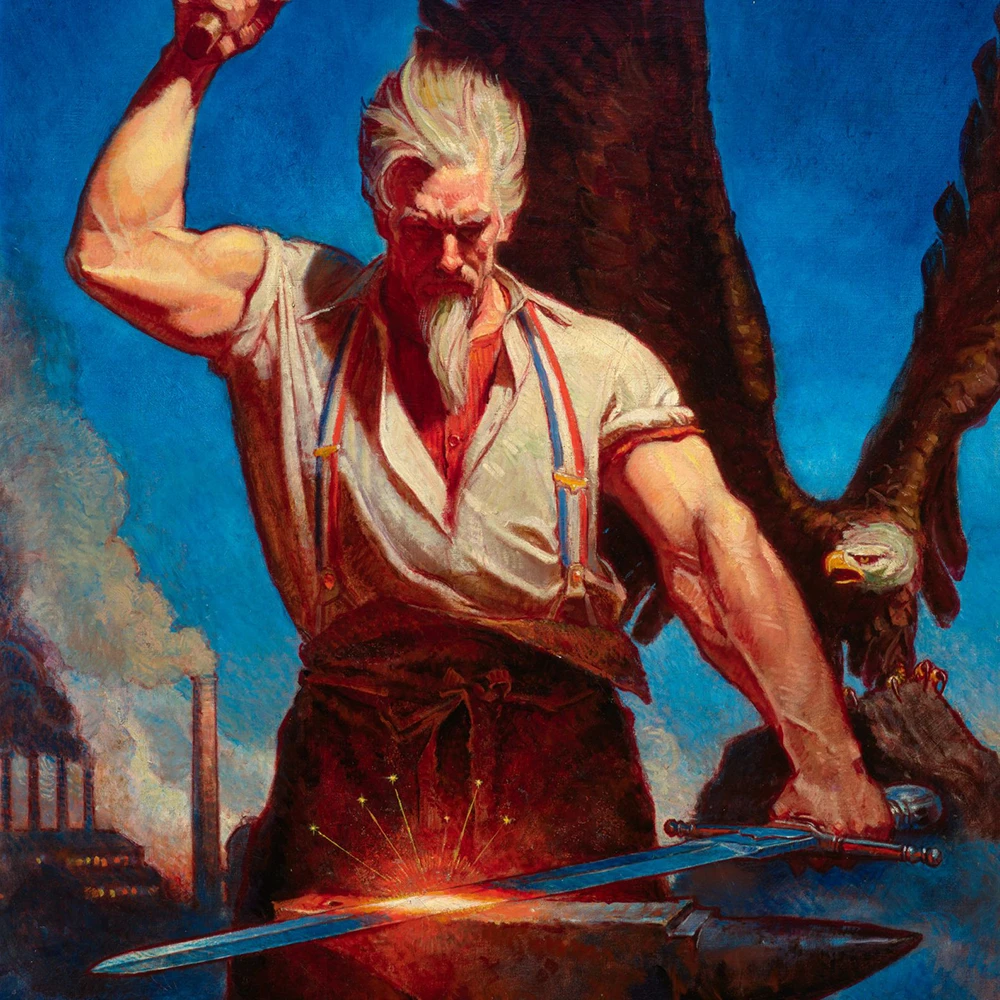
Arnold Friberg's Forging of a Nation, which graced the cover of Liberty magazine in 1941, is a powerful depiction of America's strength and spirit of freedom. In this striking piece, Friberg reimagines Uncle Sam not as the customary slender figure, but as a robust blacksmith with bulging, veined biceps, symbolizing the might of the nation. The artwork shows Uncle Sam forging a sword, a representation of America's readiness and resilience, under the vigilant gaze of an eagle, the emblem of freedom. Friberg's commitment to authenticity is evident in every detail, from the selection of Rudolph Essmaker, the first Mr. America, as the model for Uncle Sam, to the meticulous study of eagles and blacksmithing techniques. Friberg’s attention to detail is of special note in this composition. He perfectly captures the white-hot radiating heat from the sword and anvil, haloed by crackling sparks left in the wake of the last powerful strike of the hammer. Painted at a time when almost a quarter of the American workforce was employed in manufacturing, contemporaneous viewers of this image would have been quick to associate the central action with the sounds and smells of heavy machinery that at the time was the driving economic force of the nation. This painting is more than just art; it's a tribute to America's heritage and the enduring belief that strength is the foundation of freedom.



In the waning months of 1940, America was in a precarious position. The effects of the Great Depression still lingered, especially for African Americans and immigrant populations, and Hitler had successfully invaded most of Western Europe with his eyes set on London. The American citizenry had an important decision to make in that year’s general election between Franklin Delano Roosevelt and Wendell Willkie. In the midst of this tumultuous time, Arnold Friberg was tasked with creating an image in less than a week to accompany an essay written by the Secretary of the NAACP, Walter White, cutting to the heart of the nation’s political strife at that time. The original painting depicts an African American man in a suit, resting his chin on his fist, reminiscent of Rodin’s Thinker, as he holds a weight titled “votes” that he will soon place on one of the scales flanking his shoulders. The accompanying essay outlined the newly discovered power of block voting for African Americans in the northern states, which Friberg made sure to capture in his signature style. The background of the composition contains swirling clouds with an ephemeral light breaking through behind the central figure’s head, illuminating his features and heightening the intensity of the scene in the foreground. Friberg renders the central figure in massive proportion to the diminutive recreations of Willkie and Roosevelt as they sit precariously on each side of the scales, capturing the idea of an uneasy electorate that could be swayed through resolute political action.
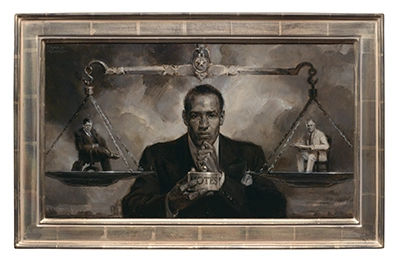



In Her Calf, a moment of tension and care unfolds as cowboys navigate cattle through a challenging deep-water crossing. Friberg captures a poignant scene where one cowboy, in a gesture of protection, scoops up a newborn calf to carry it safely across. This act sparks a misunderstanding with the calf's mother, yet both the cowboy and the mother cow are driven by the same noble intent: the safety of the calf. Friberg expertly captures this dramatic moment in vivid detail. You can feel the weight of the cow’s dripping river-soaked coat as she flexes her muscular neck while turning toward horse and rider. This pictorial reservoir of fluid motion is surrounded by Friberg’s emphasis on the arid, stucco-like treatment of the iron rich sand, gravel, and boulders that flank the central scene. The composition of this scene is so encompassing and vivid, that one can only imagine the hooves of the horse landing a moment later with a dusty crunch. This painting beautifully illustrates the often unseen moments of compassion and understanding between humans and animals against the backdrop of the rugged, yet majestic, natural world.




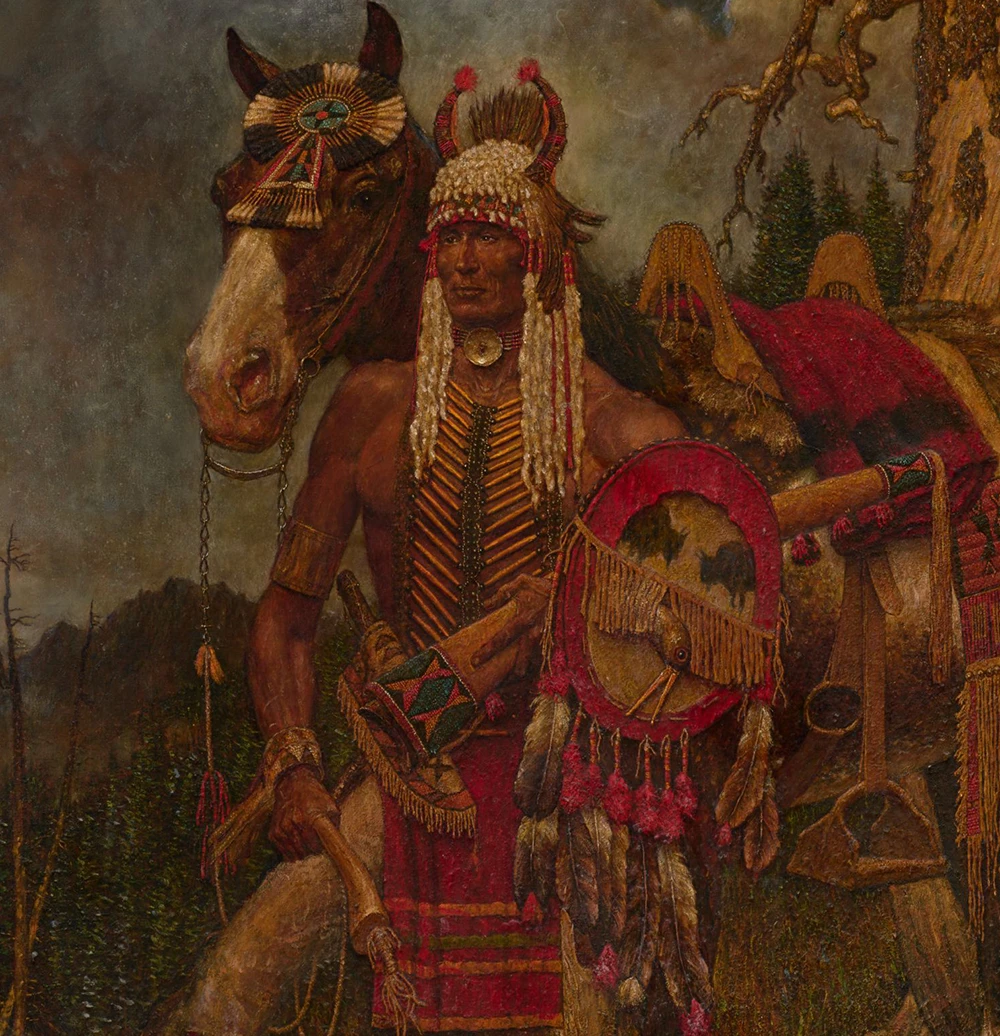
When The Land Was His masterfully portrays a Chief, encapsulating the profound connection and the poignant sense of stewardship he holds over his ancestral lands. The Chief's rugged, stoic appearance, set against a backdrop of dark, foreboding clouds, symbolizes the looming challenges faced by his people. Friberg elects to capture the intricacies of the scene and humanity of his subject via a still moment. The Chief is unmistakably an individual and not a nameless archetypal character, unlike many Western paintings of native subjects. Friberg takes special care in this work to painstakingly capture the intricate details of the attire and accoutrement of his subject. Each turquoise bead is meticulously recreated on the horse’s headpiece, the structured buckskin saddle is studded with bronze, and one can visualize the time and care taken to produce each item using rich materials provided by the land. This painting is the result of intensive research to faithfully recreate the rich heritage and craftsmanship of the subject’s culture. Friberg's painting is a powerful visual narrative, combining the stoicism of the Chief with the delicate beauty of his heritage, offering a compelling tribute to the deep, enduring bond between the land and its inhabitants.




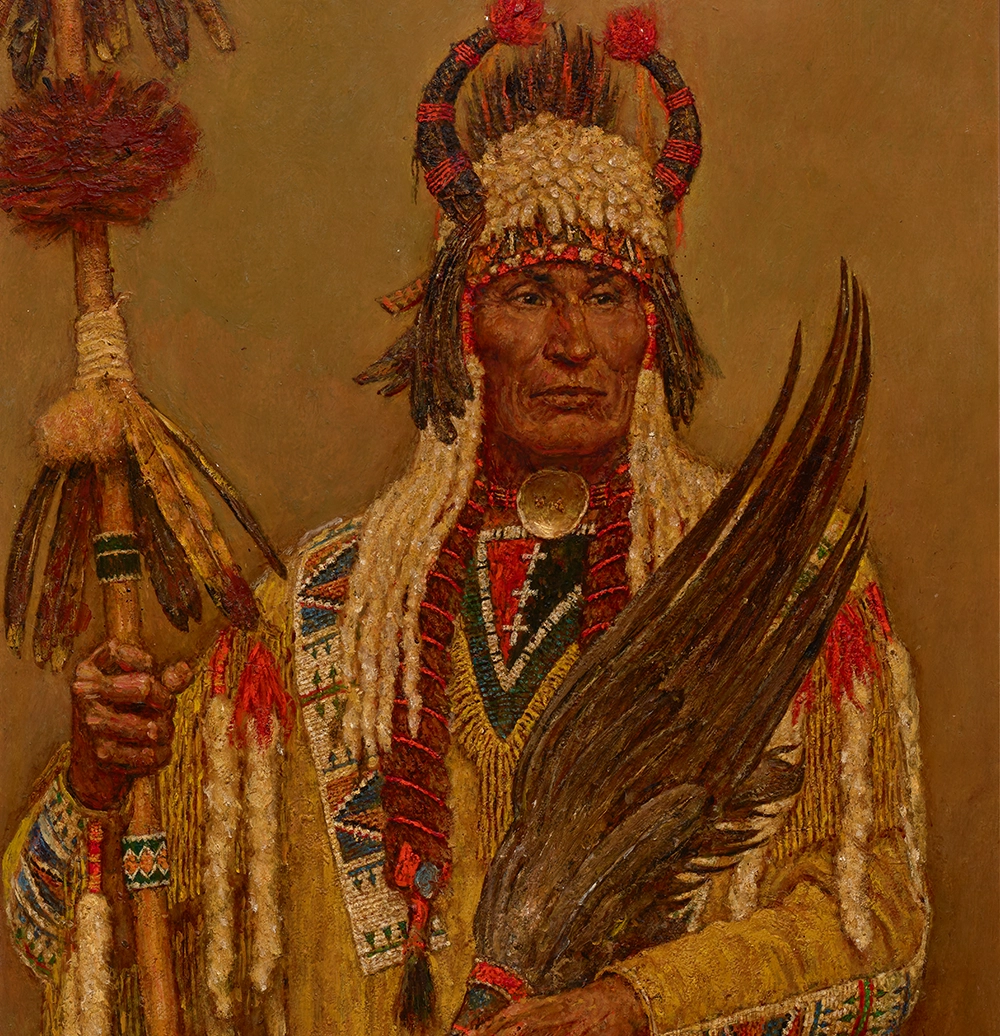
Known for his deep respect of Indigenous cultures, Friberg’s Indian Chief portrait presents a Plains ceremonial leader in full regalia, wearing a rare buffalo horn headdress - a powerful emblem traditionally reserved for spiritual leaders and elite warriors. These sacred headdresses, rich with meaning, were worn during rituals and councils, not in combat. In his left hand, the figure carries a pipe tomahawk, symbolizing both diplomacy and protective authority. In his right, he holds a ceremonial spear, adorned with feathers and possibly medicine ties—further affirming his role in ritual practice and tribal leadership. With his hallmark lighting, compositional strength, and cultural reverence, Friberg creates not just a portrait, but a visual invocation of honor, spiritual responsibility, and Indigenous continuity on the North American Plains.





In this striking portrait, Arnold Friberg captures the dignified presence of Raymond Morning Star, a respected figure of the Assiniboine people - one of the great Siouan-speaking nations of the Northern Plains. Morning Star stands adorned in a rare buffalo horn headdress, a sacred item worn by esteemed warriors and spiritual leaders during ceremonies. His posture and expression convey deep strength, composure, and connection to ancestral traditions. The Assiniboine, also known as Nakota, historically lived along the Assiniboine and Saskatchewan Rivers, across the northern plains of present-day Manitoba, Saskatchewan, and Alberta. Friberg evokes the figure in a landscape symbolic of both hardship and spiritual endurance. In his hand, Morning Star holds a pipe tomahawk, a ceremonial object of diplomacy and spiritual power, which reflects his dual role as peacemaker and protector. The overall composition, rendered with Friberg’s signature reverence and historical attention, elevates Morning Star beyond portraiture. He becomes a vessel of cultural continuity, sovereignty, and sacred tradition. This painting serves not only as a tribute to one man, but as a visual testament to the enduring strength and identity of the Assiniboine people.





Friberg's Singing Cowboy radiates the joy and spirit of the American West through the vibrant portrayal of a cowboy set against a cobalt sky. Decked in his iconic 10-gallon hat, bright red bandana, and a striking green and gold pearl-buttoned shirt adorned with a starred collar, the cowboy's cheerful demeanor is infectious. Ready for the fair, he embodies the quintessential spirit of Western folklore, singing a happy tune that seems to echo the freedom and adventure of the open range. This painting was completed early in Friberg’s career, most likely in 1931. Here the artist displays his aptitude for painting hands, showing two different positions at varying depths within the composition, which aids in creating a sense of space against the flattening effects of the matte blue background. This exceptional understanding of composition creates space for the cowboy's joyful song to ring out through the painting. Friberg's talent for capturing the essence of joy and whimsy in this piece showcases his versatility as an artist, moving beyond grand historical narratives to celebrate the lighter, everyday moments of life with the same level of artistic dedication and flair.




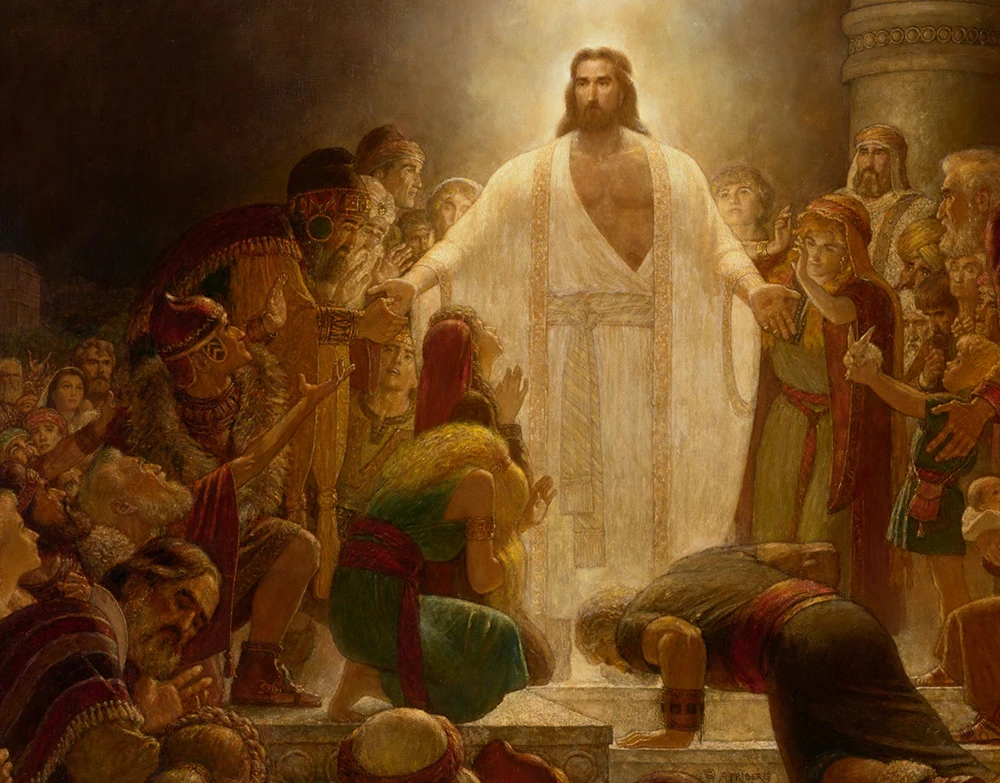
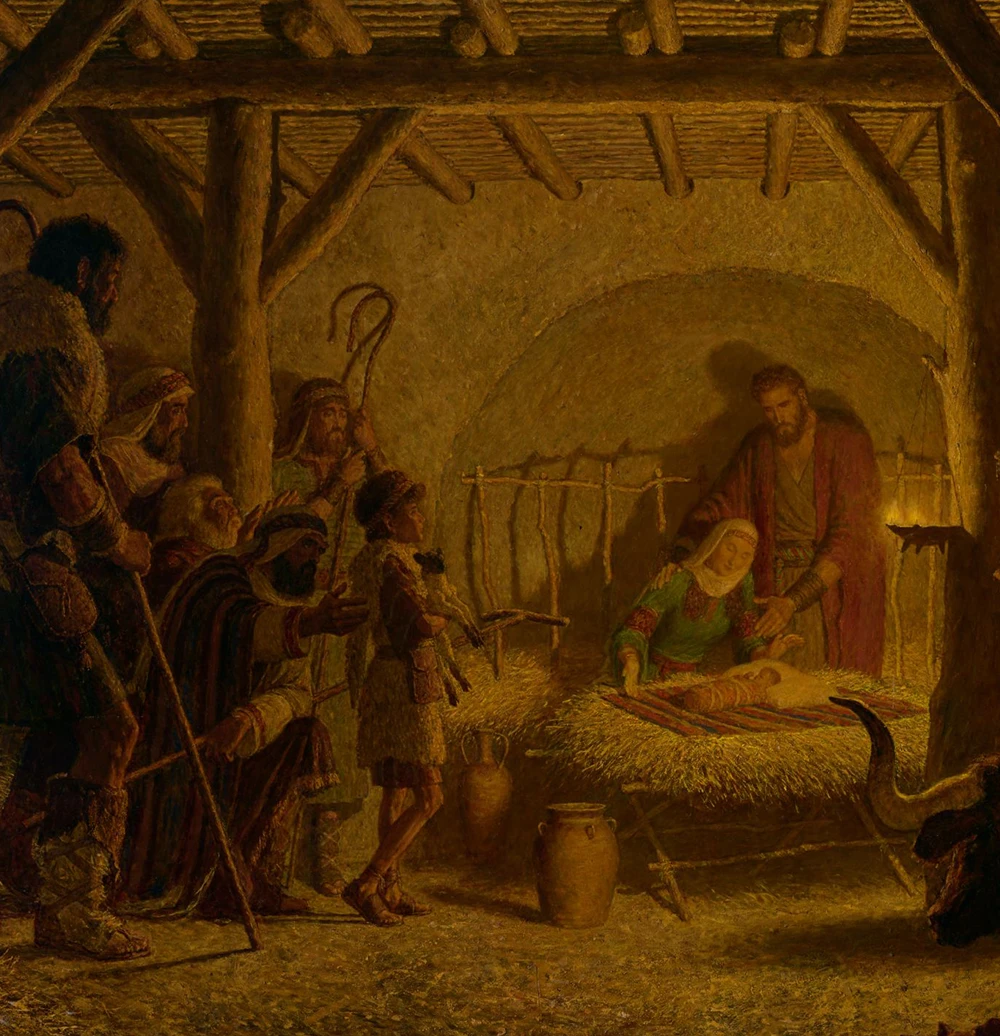

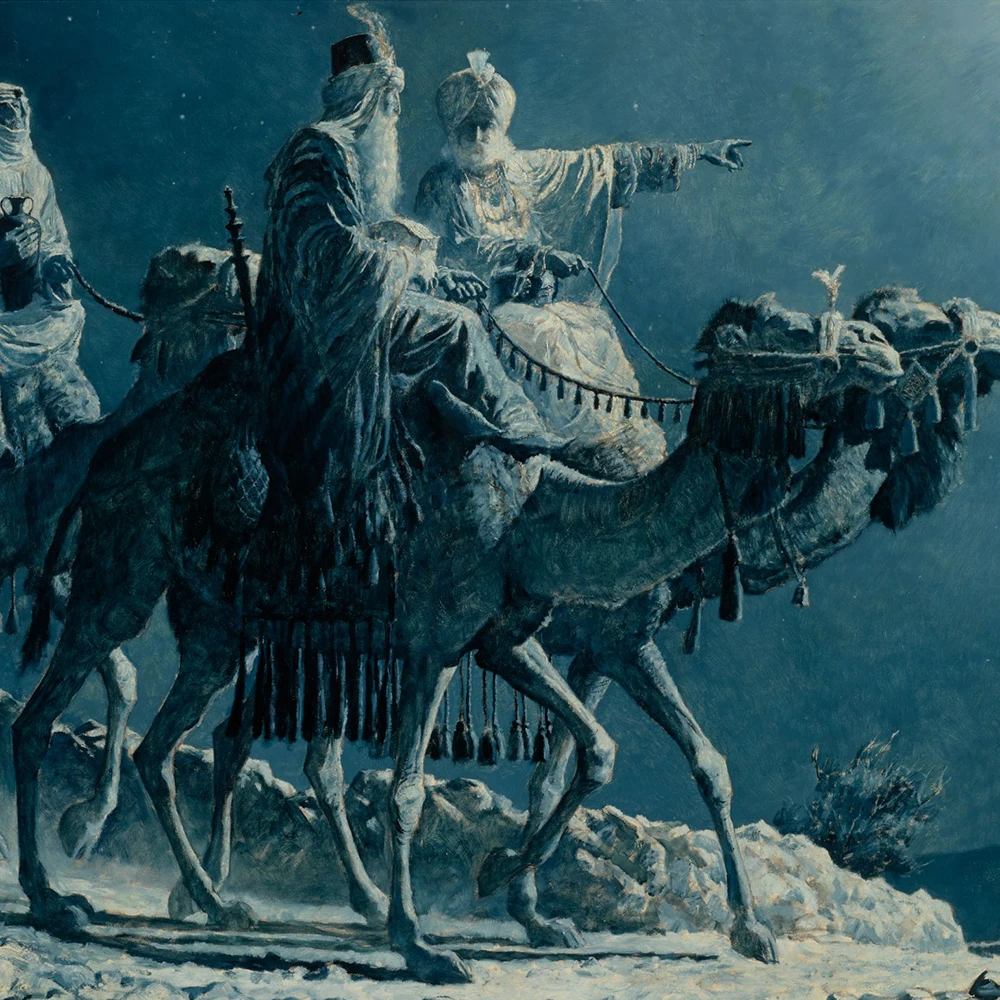
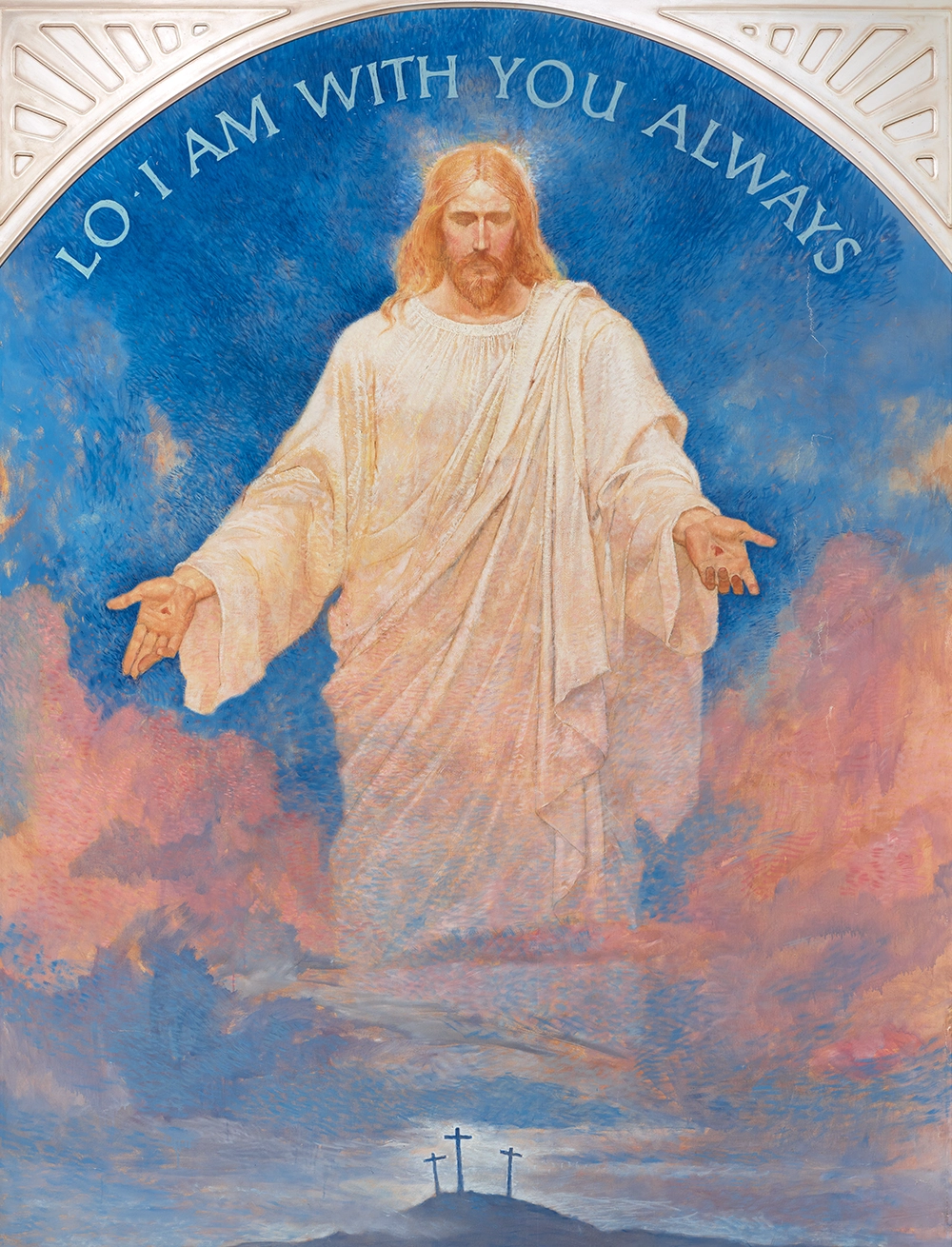

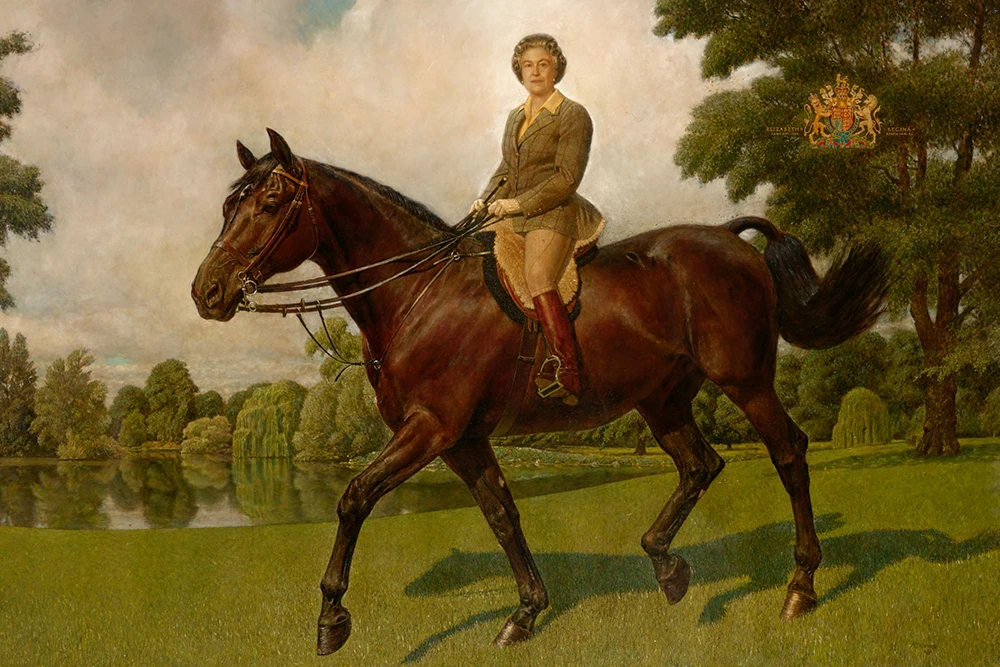
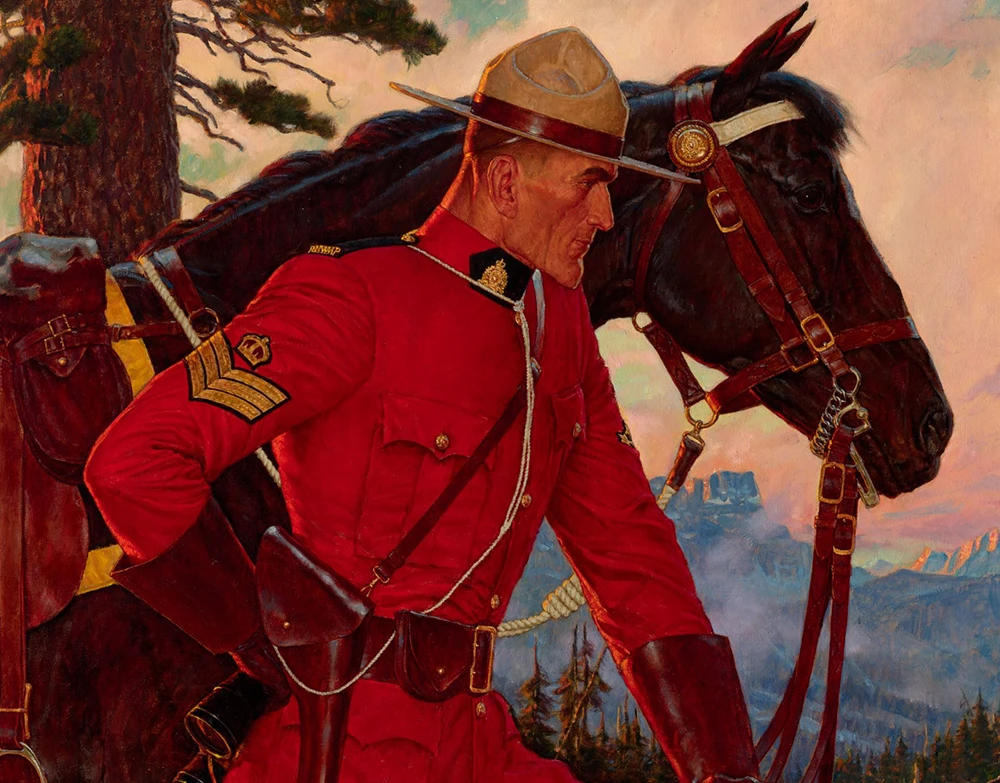
This striking portrayal of the quintessential Canadian spirit is set against the majestic backdrop of towering mountain ranges and ancient pines. This artwork captures a moment of quiet vigilance as a strong, square-jawed Mountie surveys the wilderness of Canada from an elevated vantage point. Beside him stands his horse, not just a mode of transport, but a trusted companion in the solitary task of preserving peace. In this composition, Friberg displays his exceptional ability to communicate texture and weight of materials. The leather holster on the Mountie’s waist is firm yet pliable, rendered with a slight sheen as if it had been recently shined that morning before setting off. The famous red coat is expertly recreated with thick folds and a slight impasto in the brush work, deftly capturing the rough woolen fibers of the Mountie’s first line of defense against the elements. Friberg's depiction goes beyond the physical representation of the Mountie and his horse; it delves into the deep bond between them and their shared commitment to duty amidst the vastness of the Canadian landscape. This painting is a tribute to the enduring legacy of the Royal Canadian Mounted Police, symbolizing their role as guardians of the nation's natural beauty and peace.



In Mountie Watering Horse and Packhorse in Lake, Friberg beautifully captures the serene yet profound connection between the Royal Canadian Mounted Police (Mounties) and the rugged Canadian wilderness they are sworn to protect. The painting presents a tranquil scene where the vastness of the landscape, with its endless blue skies and reflective waters, is momentarily intersected by the snow-capped mountains and the noble silhouette of Canada's guardians. This trio, consisting of a Mountie and his two horses—one for supplies and shelter, the other a loyal steed—embodies the essence of duty and companionship. The two horses are depicted gently interacting with the calm waters that surround them. Friberg’s mastery of depicting fluid motion is evident in the gentle waves that emanate from the light movements of both horses such that their reflections are still clear with an expertly rendered distortion in the brushwork of the wave rings. Friberg's artistic depiction is a testament to the solitude and responsibility borne by the Mounties, highlighting their deep bond with their horses as they navigate and safeguard the expansive wilds of Canada. The harmony between man and nature, underscored by the striking natural beauty and the essential roles each character plays, evokes a sense of calm and resilience that is emblematic of the Canadian spirit.


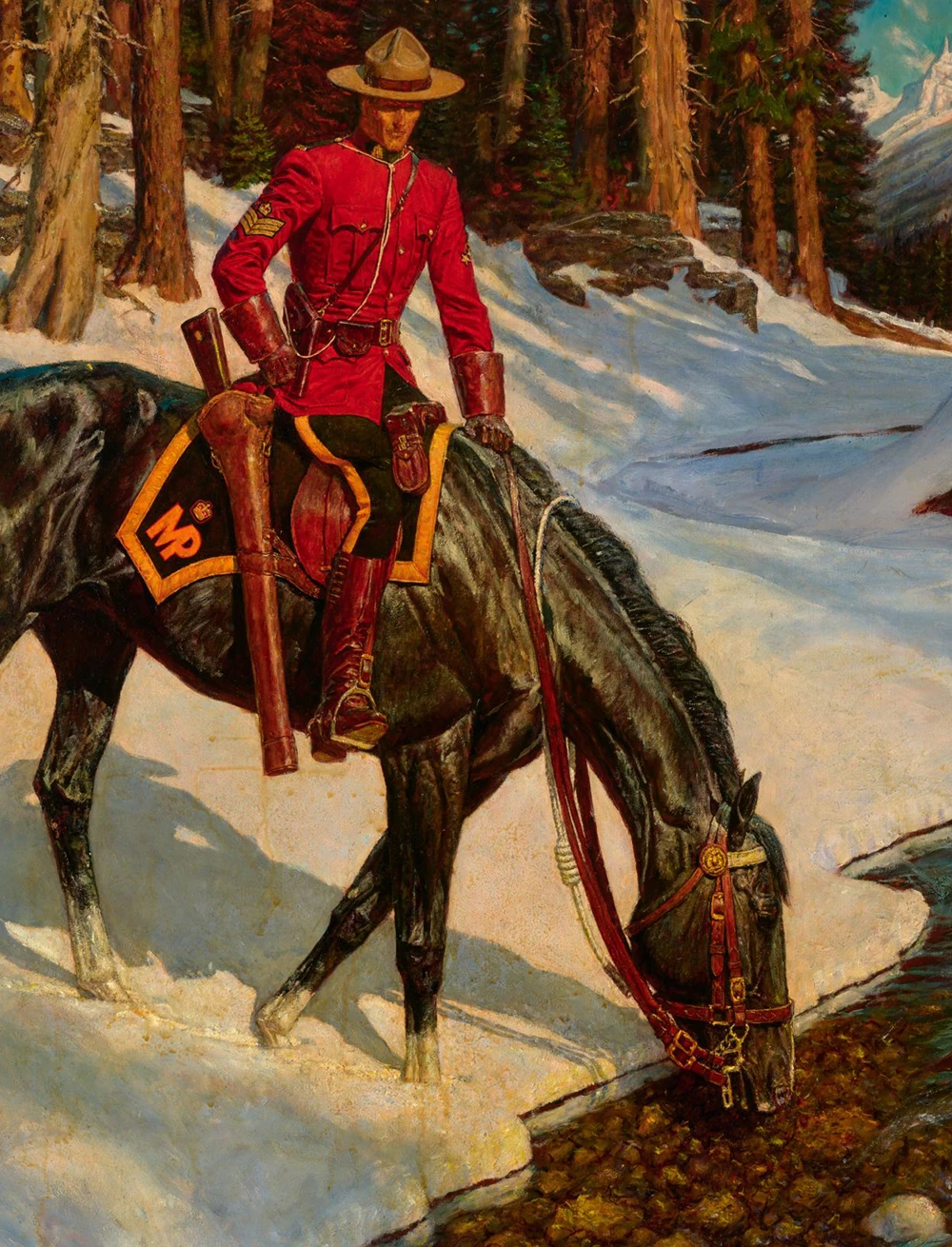
Springtime in the North offers a refreshing perspective on the familiar theme of the Mounties, this time with a special emphasis on the horse. As the spring sun filters through the trees and over the mountains, melting snow feeds into a blue brook, providing a drink for the Mountie's thirsty companion. In this piece, it is the horse that captures the viewer's attention, a testament to Friberg's unmatched ability to render the power and beauty of these treasured animals. The horse, with its well-defined muscles and lustrous coat, stands as a symbol of strength and composure as it takes a drink from the coursing brook. Friberg captures the speed and energy of the cascading water, just freed from its frozen slumber atop the mountain above. This revitalizing spring is provided to horse and rider by the abundant landscape that surrounds them as they continue to the important task at hand. Friberg's skillful portrayal of the horse, set against the backdrop of the North's awakening beauty, showcases not just the animal's majesty but also the intimate connection between the Mountie and his steed. This painting invites us to appreciate the quieter moments of connection with nature, highlighting the serene beauty of the northern wilderness as it comes to life in spring.


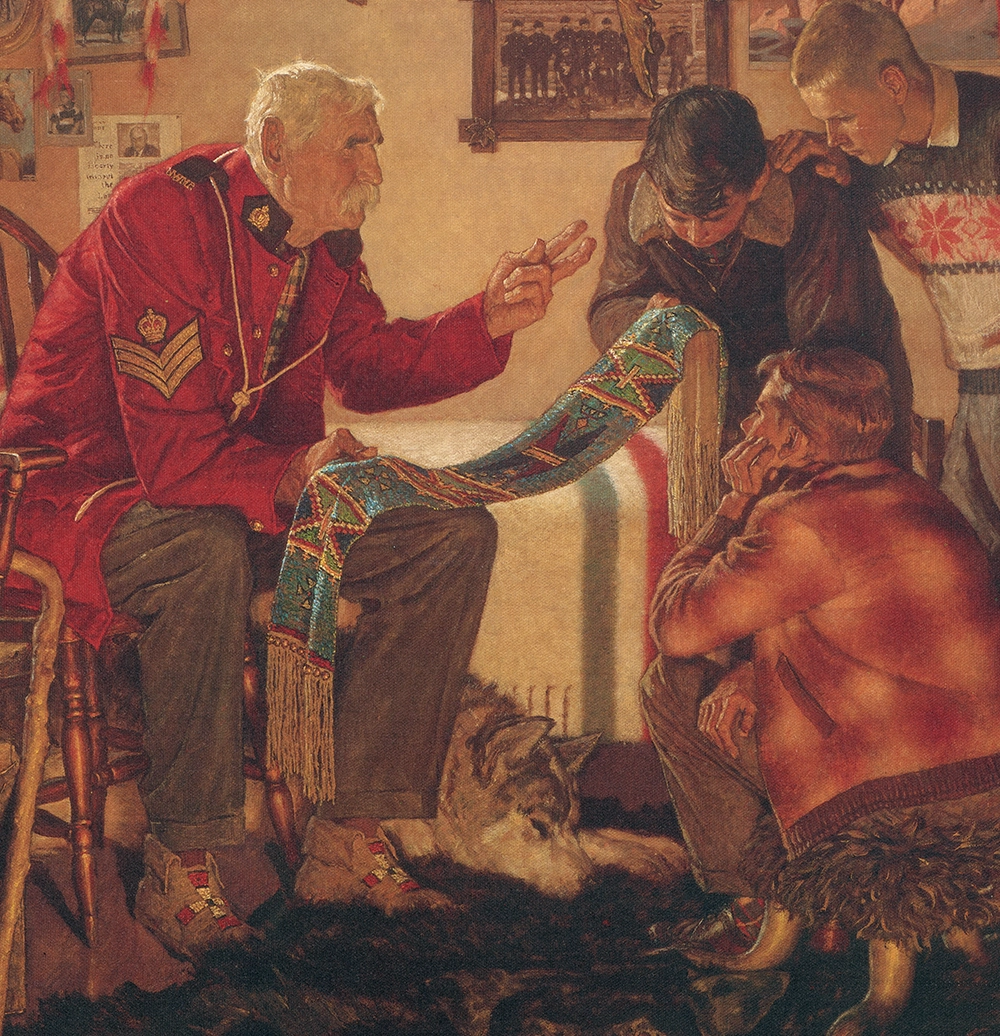
In this tender and richly detailed interior scene, Arnold Friberg captures a poignant moment of storytelling across generations. A retired Royal Canadian Mounted Police officer, proudly dressed in the iconic scarlet tunic, recounts his experiences of service and adventure to an enraptured trio—a young man and two boys. The intimacy of the setting—with its warm firelight, fur rugs, and walls adorned with regalia and memorabilia—transforms the room into a living archive of memory and meaning. The RCMP veteran, seated and gesturing with quiet authority, is both a keeper of law and a custodian of lived experience. The young listeners gather around him not simply as passive observers, but as inheritors of a rich cultural legacy. Friberg’s reverence for cross-cultural respect and intergenerational wisdom is palpable in every carefully rendered detail. Tales of the Force is more than a nostalgic vignette—it is a visual testament to the enduring power of shared stories, mutual respect, and the quiet dignity that bridges generations through the act of remembrance.


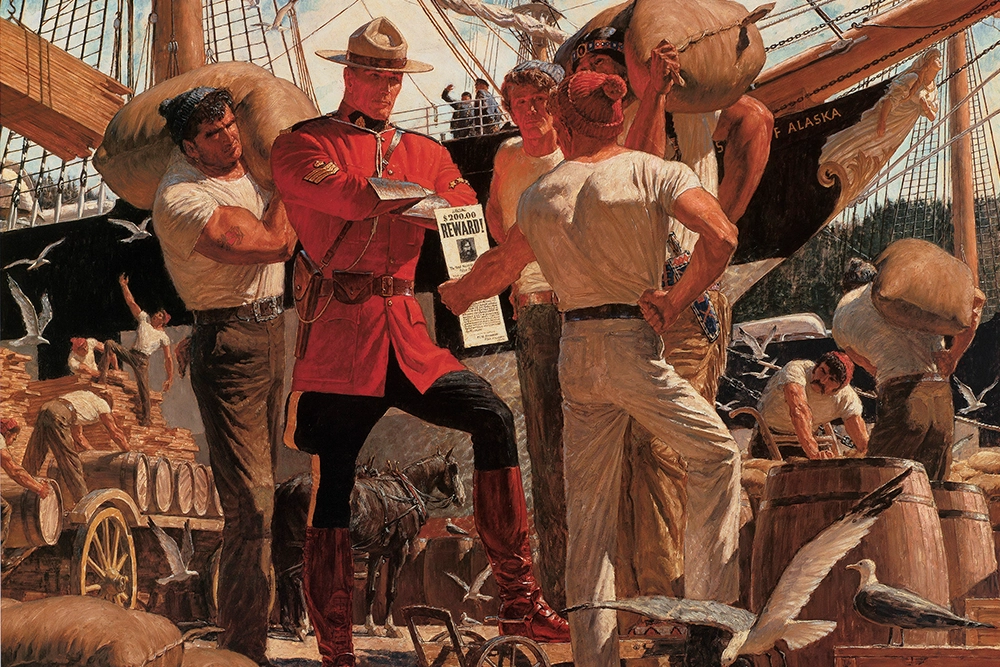
Arnold Friberg’s series of paintings featuring the Royal Canadian Mounted Police stand out as one of the crowning achievements of his career. Beloved by former and current members of the RCMP, these paintings exemplify Friberg’s obsession with detail and enveloping his viewers in sumptuous compositions. In Trail Ends at the Sea, the viewer is greeted by a swirl of animals, humans, and raw materials caught in a freeze frame. The RCMP officer, cloaked in brilliant red, stands stalwart and accusingly as the longshoremen break from their work to examine a wanted poster. Heavy burlap sacks sit heavily on the shoulders of two figures in the central group, while more lay resting in the foreground. The small rendering of the wanted man looks suspiciously similar to the worker with the mustache in the background looking up at the officer and his fellow laborers with an air of concern on his face. The entire scene is an explosion of color and texture. One can almost hear the caws of the seagulls scattered throughout and smell the freshly cut raw timber being loaded on the masted ship framing the scene. Friberg has created an immersive experience for the viewer to fully appreciate the sensory feel of life in the Canadian frontier.


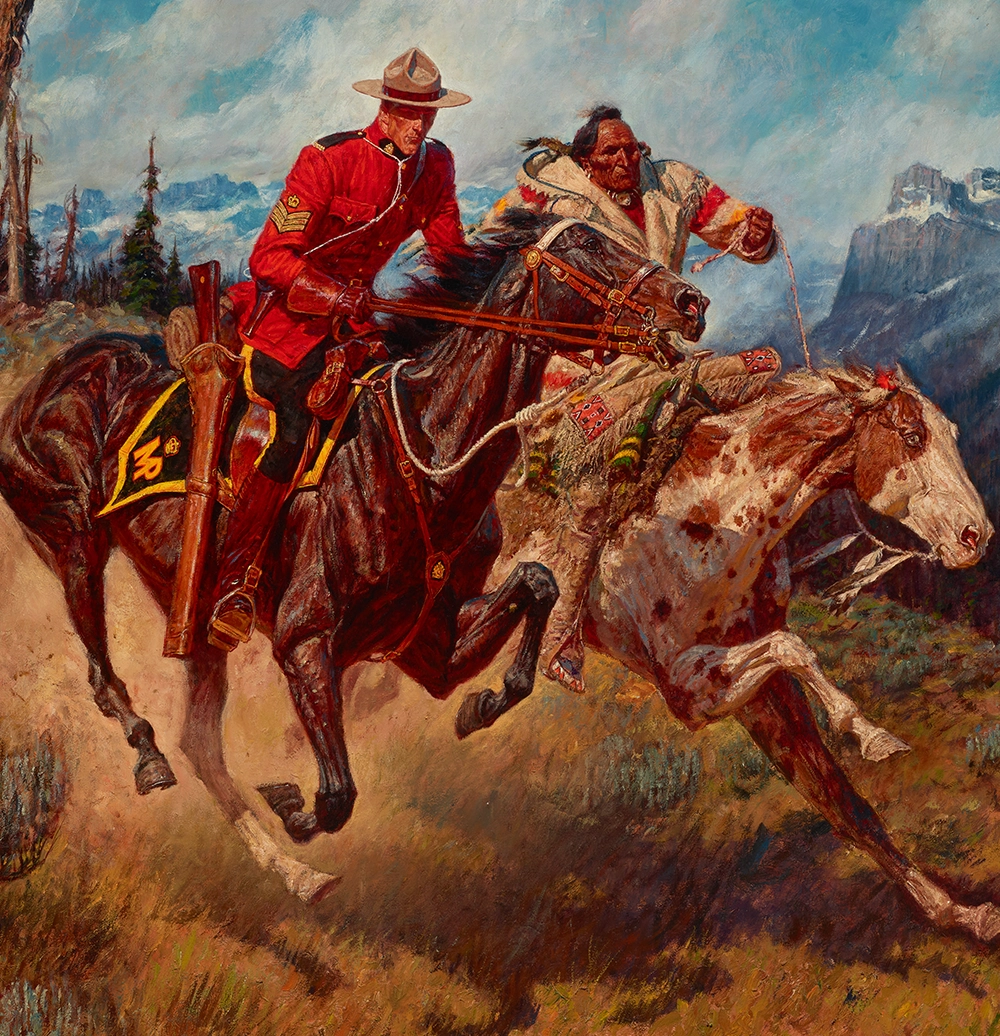
In this thrilling composition, Arnold Friberg captures a moment of shared purpose and urgency between two iconic figures of Canadian frontier life: a Royal Canadian Mounted Police officer and an Indigenous guide, thundering side-by-side across a rugged wilderness trail. The drama of the chase is evident with wind-torn garments, flaring nostrils, pounding hooves with precision and painterly restraint. Friberg brings equal weight to both riders. The Mountie, in scarlet uniform, represents the law and order of a young nation, while the Indigenous Indian guide, riding bareback with striking agility and traditional attire, embodies deep ancestral knowledge of land and survival. Together, they ride not in opposition but in partnership - an idealized vision of collaboration amid the challenges of colonial expansion. Set against a sweeping backdrop of the Canadian Rockies, On Swift Horses blends historical narrative with romanticism. It is a timeless emblem of frontier endurance, cross-cultural respect, and shared destiny in the wilderness of the North.



Set deep in a snow-covered northern wilderness, this striking painting by Arnold Friberg captures the resilience and commitment of a Royal Canadian Mounted Police officer forging a path through the backcountry. Clad in bright red serge, fur-trimmed mitts, and snowshoes, the Mountie breaks trail ahead of a determined dog team hauling supplies, their bodies tense with effort, breath misting in the icy air. Friberg’s portrayal is both physically dynamic and deeply symbolic. The officer’s forward-leaning posture and focused expression speak to the quiet heroism of isolation, endurance, and duty in unforgiving conditions. The thick forest, heavy with snow, frames the trail as a frontier of persistence which is challenging, beautiful, and vast. From the disciplined rhythm of the dogs to the glint of sunlight on the snow, every element conveys movement and purpose. Mountie Breaking Trail for Dog Team is not simply a winter scene, but a tribute to the spirit of northern service and bravery - where man and animal rely on each other, and where the journey itself is an act of devotion to the land and those who depend on it.


